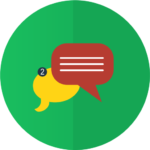EMAIL MARKETING FOR AUTHORS: HOW TO NURTURE YOUR AUTHOR PLATFORM FOR EFFECTIVE RESULTS
Your reader relationship starts when you get the email address... so, what's next?

HOW TO NURTURE YOUR AUTHOR PLATFORM FOR EFFECTIVE RESULTS
By Belinda Griffin
So you did what everyone said, you set up a blog, hooked up a reader magnet and started growing an email list. You’re on several social media platforms and diligently posting daily. You’re careful not to only blast out messages about your books, but instead share thoughtfully composed, useful and entertaining posts.
You are completely and utterly drained and, to make things worse, you’re still not seeing much engagement from the ‘platform’ you have so carefully built from scratch.
Wasn’t it supposed to be easier than this? Wasn’t the platform everyone told you to grow supposed to be the magic bullet to launch your author career?
[Note from Nick: I call this situation “Author Marketing Hell” and it’s something you need to avoid at all costs]
Don’t worry, I’m not here to tell you it has all been for nothing. It hasn’t. But there is still one more thing you need to do.
What is an author platform anyway?
Let’s step back a minute. In case you’re not familiar with the term ‘author platform’, it’s the name given to your connection with your fans and potential buyers of your books. An author platform is a vehicle for communicating with readers and spreading your message.
Platforms can look very different for different authors; some may have a blog, others a podcast, most have an email list but others may run a popular Facebook group. Your platform is any and all of the ways in which you reach out to your readers and entice them into your world.
An author platform is an important focus for authors with a long-term vision and is the most cost-effective and efficient long-term book marketing strategy.
The problem, however, is that although there are numerous resources out there exalting the benefits of an author platform, and several more explaining how to start building one, there is less information available about what to do with one once you have it.
Author platforms require constant maintenance
Unfortunately, an author platform isn’t something you build following some sort of architect’s blueprint and, sorry to disappoint, but it will never be finished. At least, you’ll never be able to set it and forget it.
A platform, once you have one, will require constant maintenance and tending to prevent rot from setting in.
In other words, you need to nurture it.
Many authors begin building their platform with some idea in their mind about what they are hoping to grow. Perhaps the aim is a list of 1,000 email subscribers, perhaps it’s a certain number of Facebook fans or Twitter followers.
But here’s the thing. A platform starts with just one person.

A platform starts with one fan
It is good to set goals and targets and to monitor your progress towards those goals, but it’s important to remember that your platform begins with your very first follower.
That means that, even if you only have one email subscriber, you must send regular engaging content just as you would if you had reached your 1,000 subscribers goal.
There are a few reasons for this:
- Your first email subscriber doesn’t know they’re the only one, so you have the opportunity to act professionally from the very start and give a great first impression. You don’t need to pretend you’re something you’re not, but you don’t need to let them think you’re a beginner either.
- If you start off the way you mean to go on and treat each and every subscriber as if they are your only subscriber and you are grateful to have them on board, they are more likely to stick with you. They will appreciate you appreciating them and will more happily share your content and tell others about you. It actually becomes harder to maintain this as your following gets bigger, so start as you mean to go on.
- You have to start somewhere, and every single individual that makes up your following is equally important. So if you take the first 1, 10, 100 for granted because you don’t think you have enough to worry about yet, you have got the whole idea of platform building very wrong. Every follower matters.
Have a plan in place
Fortunately, nurturing a platform is in many ways no different to building a platform. It’s about sharing engaging content and providing value. We do that to encourage people to follow us in the first place, but we must continue to do it if we want to keep those followers – remember, numbers can go down as well as up.
For example, you have an enticing reader magnet on your blog offering something irresistible in exchange for an email address, but once you have that subscriber, how well do you look after them?
You want to have a plan because, depending on how you are driving traffic to your sign up, once you have a reader magnet in place, things can grow fast. All the way back in late 2014, Joanna Penn was able to add 1,652 subscribers to her fiction list in just two months following tips from Nick Stephenson.
But if after receiving your reader magnet you forget about your subscribers, there is a good chance they will unsubscribe the next time they hear from you, because they no longer remember who you are or why they signed up.
On the other hand, if you treat your subscribers well they are more likely to help spread the word for you, telling their friends about the awesome new author they’ve found.

How to look after your followers
It’s a good idea to have a series of welcome emails that introduce new subscribers to you and your books and to let them know what to expect from you.
For example, a simple welcome series could go like this:
- Email 1: ‘Thanks for signing up, here’s your free gift (include the link to download your reader magnet). I’d love to hear what you think.’ Let subscribers know what kinds of emails to expect from you and how often, such as weekly blog posts and regular updates on your writing progress.
- Email 2: Reminder to download the free gift. Ask subscribers to tell you more about themselves (eg, what kinds of stories they love to read, who are their favourite authors/books etc)
- Email 3: Let subscribers know about any books you currently have for sale. This isn’t a sales email, you’re simply letting them know because they have expressed an interest in your reader magnet, so it makes sense to tell them what else you have available.
- Email 4: Offer something else of value – perhaps encourage subscribers to check out your blog or like your Facebook page.
- Email 5: Reveal a bit more about yourself. Talk about your writing, but also share something personal about yourself, such as where in the world you live and who with, your hobbies (other than writing!) and writers you admire. It’s up to you what to share, but the aim is to let readers get to know you as a real person they can relate to.
- Email 6: Ask subscribers to share the link to your reader magnet if they enjoyed it, to help spread the word.
The idea is to encourage engagement. You want to get to know your readers better, plus you want to train them to open and respond to your emails. This will be important when it comes time to sell a new book.
It’s easy to set up these emails using an email service provider, such as Mailchimp, and schedule them to send automatically when a new subscriber joins your list. You can also choose how many days apart the emails should send.

Keep your promises
And then you must follow through on any promises you made. If you said you will send a weekly blog update, you will need to write a weekly blog.
Make a plan for the content you will produce and how often, and try to avoid missing your own deadlines. It’s easy to think that when you only have a handful of followers it doesn’t matter if you miss posting for a few weeks, but it does matter. It’s important to keep your promises if you want to be taken seriously.
It’s also important to keep your promises to yourself. Keep your ‘why’ front and centre for motivation, so you remember what the point of all this is and why it matters to you.
As well as blogs and emails, you may want to up your social media activity. I once carried out an experiment on Facebook for a client. I was able to grow their Facebook engagement by 129% over a three-month period by following a daily posting strategy. That was back in 2016 and since then Facebook has made a number of changes to make engagement even more important if you want your page to show up in your followers’ feeds.
A hit and miss approach to your social media will do nothing to nurture your platform. If you’re going to use it, learn to use it well.

Make a schedule & stick to it
Take out your calendar and make a schedule of when you can create content, such as blog posts or emails, and when you will post content – when you will post on social media, when you will send emails, when you will promote blog posts, for example.
Depending on the platform you’re building and where you prioritise spending most of your time, your schedule could look very different to someone else’s. That doesn’t matter, as long as it works for you and your followers.
For example, I have a plan for the next three months of blog content. I blog weekly, posting on a Wednesday morning and sending out an email on Wednesday afternoon. I know that producing a full-length blog each week, alongside the guest posts I write, will soon lead to burn-out.
To avoid this, I schedule in a monthly round-up post, which is much easier to produce so gives me a chance to catch my breath while still providing value for my readers. Plus, it allows me to give a shout out to other bloggers I respect.
For social media, I have a promotion plan for my own blogs, posting to my preferred networks of Twitter, Facebook and Pinterest. Your plan could include Instagram, LinkedIn or Google+.
It’s important to share other people’s content even more than your own, so build in time to check out other blogs and social feeds to find content to share. I have a weekly routine where I check out my list of favourite blogs and podcasts and schedule content to share. I use CoSchedule, but there are many other scheduling tools available, both free and paid.
You do not need to spend hours and hours on social media, but you need to make a plan to ensure the time you do spend is working effectively for you.

Your fans want to hear from you
Your fans don’t only want to hear from you when you have a new book to share. And they certainly don’t want to only hear from you when you want something from them – to help with a launch, for example, whether as a beta reader, a reviewer, or a buyer.
Your followers want to know what you’re up to and what you’re working on between books. Take some time to think about what sort of things you want to talk about on your blog and in your emails, as consistency will help to develop your author brand.
For example, as a fiction author you can write about what you’re currently working on and the research you are doing.
Talk about places you visit as part of your research and include plenty of photos. You could blog book reviews or about what you are learning about the craft of writing.
Coming up with a theme for your blog can be easier for a non-fiction author, as you will most likely blog about the same topic as in your book. Icy Sedgwick has some awesome ideas for building your author brand with a blog.
Most importantly, subscribers don’t want to sign up to your list and then have to wait to hear from you while you grow to what you think is ‘big enough’.
When that first person signs up, you’re big enough. They have clicked subscribe because they want to hear more from you and are interested in what you have to offer.
Therefore, whether you feel like you’re ready or not, it’s time to step up and take your platform seriously, because things just got real.
 Belinda Griffin is a Book Marketing Success Coach teaching indie authors who struggle with book marketing how to attract their ideal readers who will fall in love with them, so that they can confidently achieve much greater exposure and sales. Belinda runs SmartAuthorsLab where authors embrace experimentation, to see what works for them. Grab your FREE guide: How to get your book noticed with fantastic results! & follow Belinda on Twitter@SmartAuthors.
Belinda Griffin is a Book Marketing Success Coach teaching indie authors who struggle with book marketing how to attract their ideal readers who will fall in love with them, so that they can confidently achieve much greater exposure and sales. Belinda runs SmartAuthorsLab where authors embrace experimentation, to see what works for them. Grab your FREE guide: How to get your book noticed with fantastic results! & follow Belinda on Twitter@SmartAuthors.
Further Reading: For more on how to avoid “Author Marketing Hell” and focus on a scalable strategy that pulls readers towards you and leads them on the journey to the sale, check out our free article series right here.

No comments:
Post a Comment